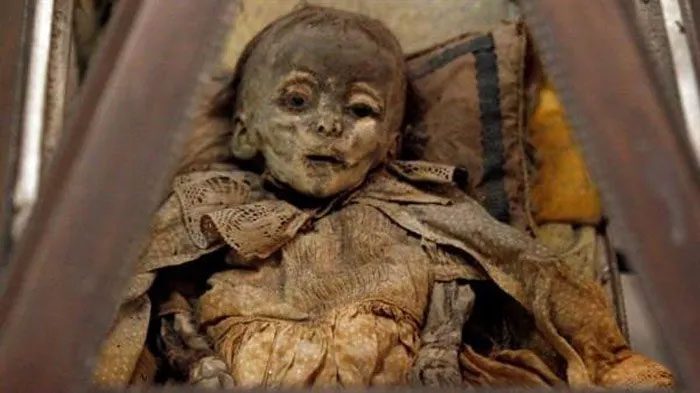A team of scientists is trying to understand why dozens of children were buried together in a crypt on the island of Sicily, Italy.
The Capuchin Catacombs, a spooky tourist attraction in Palermo, northern Sicily, Italy, has long been shrouded in mysteries that remain unanswered.
Recently, a team of scientists led by Kirsty Squires from Staffordshire University in the UK has begun fieldwork and research into one of the mysteries there.

Mummies still dressed in full clothing, some placed in cribs.
The team will investigate 41 child mummies hidden in a private section of the catacombs, out of a total of 163 child mummies buried throughout the entire site.
Kirsty Squires stated: “We want to learn about the lives of these children before they died, their health, development, and the reasons behind this phenomenon.”
The mummies are still fully clothed, with some placed in cribs or chairs, while others are positioned standing, supported by sticks. Some child mummies are preserved so well that they resemble “little dolls.”
Currently, there is very little information about the children in the catacombs. They were buried between 1787 and 1880, making it one of the largest mummy catacombs in Europe.
According to Kirsty Squires, the children in the catacombs mostly came from middle-class families, as the embalming process was typically reserved for wealthy families such as nobility, the middle class, and clergy.
“We know that they were not the poorest members of society. But that is all we know. Why were they not buried like others at that time? We need to study further,” Kirsty Squires said.
The research team will use X-rays as this method is non-invasive and does not cause other issues. They will use a portable X-ray machine to estimate the age of each mummy based on tooth development and bone growth.
The researchers will analyze a total of 574 X-ray images to fill in the biological records of the children and investigate whether embalming was performed only on individuals of certain ages or genders.
Through this method, they hope to discover the presence of developmental defects, stress indicators, and pathological damage, aiming to gain insights into the health and lifestyles of the children.
According to Squires, embalming was seen as “a way to preserve the social identity of individuals after death,” allowing family members to visit and see the remains of their loved ones.





















































